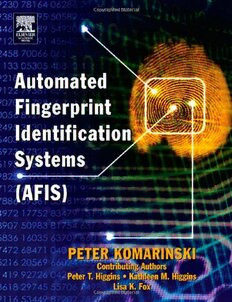Table Of ContentAUTOMATED FINGERPRINT
IDENTIFICATION SYSTEMS
(AFIS)
AUTOMATED FINGERPRINT
IDENTIFICATION SYSTEMS
(AFIS)
Peter Komarinski
With contributions by:
Peter T. Higgins and Kathleen M. Higgins
Lisa K. Fox
Amsterdam • Boston • Heidelberg • London • New York • Oxford • Paris
San Diego • San Francisco • Singapore • Sydney • Tokyo
Acquisitions Editor Mark Listewnik
Project Manager Sarah M. Hajduk
Associate Acquisitions Editor Jennifer Soucy
Developmental Editor Pamela Chester
Marketing Manager Christian Nolin
Cover Design Eric DeCicco
Interior Design Kenneth Burnley
Composition SNP Best-set Typesetter Ltd., Hong Kong
Cover Printer Phoenix Color
Printer The Maple-Vail Book Manufacturing Group
Elsevier Academic Press
30 Corporate Drive, Suite 400, Burlington, MA 01803, USA
525B Street, Suite 1900, San Diego, California 92101-4495, USA
84 Theobald’s Road, London WC1X 8RR, UK
This book is printed on acid-free paper.
Copyright © 2005, Elsevier Inc. All rights reserved. Except Appendix B © 1998 International
Association for Identification. Used with permission.
No part of this publication may be reproduced or transmitted in any form or by any means,
electronic or mechanical, including photocopy, recording, or any information storage and
retrieval system, without permission in writing from the publisher.
Permissions may be sought directly from Elsevier’s Science & Technology Rights Department in
Oxford, UK: phone: (+44) 1865 843830, fax: (+44) 1865 853333, e-mail:
[email protected]. You may also complete your request on-line via the Elsevier
homepage (http://elsevier.com), by selecting “Customer Support” and then “Obtaining
Permissions.”
Library of Congress Cataloging-in-Publication Data
APPLICATION SUBMITTED
British Library Cataloguing in Publication Data
A catalogue record for this book is available from the British Library
ISBN: 0-12-418351-4
For all information on all Elsevier Academic Press Publications
visit our Web site at www.books.elsevier.com
Printed in the United States of America
04 05 06 07 08 09 9 8 7 6 5 4 3 2 1
To my family, especially my wife Mary Kay, who supported my endeavors, and
my friends in the AFIS community who work tirelessly to make the world better.
It is an honor to work with so many dedicated and talented individuals.
CONTENTS
FOREWORD xiii
CHAPTER 1 INTRODUCTION 1
1.1 Welcome 1
1.2 Fingerprints 3
1.3 What Is AFIS? 4
1.4 Identification Practices Prior to AFIS Systems 8
1.5 Current Identification Practices 10
1.6 Why Fingerprint-Based Checks Are Important 12
1.7 From Paper to Paperless 13
1.7.1 Paper: The Fingerprint Card 13
1.7.2 Paperless: Livescan 13
1.8 The Impact of AFIS Systems 15
1.9 Other AFIS Issues 16
1.10 Why This Book Was Written 18
1.11 Who This Book Is Intended For 20
1.12 Chapter Overview 23
1.12.1 Chapter 2 History of Automated Fingerprint Identification System 24
1.12.2 Chapter 3 Fingerprints Are Unique 24
1.12.3 Chapter 4 AFIS Summary—How the System Works 24
1.12.4 Chapter 5 From Print to Identification 25
1.12.5 Chapter 6 Current Issues 25
1.12.6 Chapter 7 Buying an AFIS System: The Basic Documents Needed 26
1.12.7 Chapter 8 Standards and Interoperability 26
1.12.8 Chapter 9 Contractual Issues Regarding the Purchase of an
Automated Fingerprint Identification System 26
1.12.9 Chapter 10 Case Study—Diamonds in the Rough: Increasing the
Number of Latent Print Identifications 27
1.12.10 Appendices 27
CHAPTER 2 HISTORY OF AUTOMATED FINGERPRINT IDENTIFICATION SYSTEM 29
2.1 Early Prints 29
2.2 Moving Beyond a Single Database 32
2.3 Fingerprint (Tenprint) Cards 33
viii AUTOMATED FINGERPRINT IDENTIFICATION SYSTEMS
2.4 Latent Print Processing 36
2.5 The First AFIS System 37
2.6 Growth and Development of AFIS Systems 39
2.7 IAFIS: The AFIS That Changed the World of Fingerprint Automation 41
2.7.1 Transmission Standard 46
2.7.2 FBI and Other Implementations of the ANSI Standard 47
2.7.3 Image Quality Specifications 48
2.7.4 Compression Standard 49
2.7.5 Conclusion 50
2.7.6 Current Challenges 50
CHAPTER 3 FINGERPRINTS ARE UNIQUE 53
3.1 Names 53
3.2 Identification Documents 54
3.2.1 Driver’s License 55
3.2.2 Passport 57
3.3 Photographs 59
3.4 DNA 61
3.5 Fingerprints 61
3.5.1 Physical Characteristics 61
3.5.2 Proven Uniqueness? 62
3.5.3 Image Quality 64
3.6 Classification Systems 66
3.6.1 The NCIC System 66
3.6.2 The Henry and American Classification Systems 68
3.6.3 Filing Systems 70
CHAPTER 4 AFIS SUMMARY—HOW THE SYSTEM WORKS 73
4.1 Databases 73
4.2 Processing Overview 76
4.2.1 Tenprint 76
4.2.2 The Latent Print Process 80
4.2.3 Unsolved Latent Search 83
4.2.4 Latent/Latent Search 84
4.3 Why AFIS Systems Work 84
4.4 Why Are Some Identifications Missed? 86
CHAPTER 5 FROM PRINT TO IDENTIFICATION 89
5.1 AFIS Components 89
5.1.1 Physical Layout of AFIS 90
5.1.2 AFIS Hardware 90
5.1.3 Coders 93
5.1.4 RAID Storage 95
5.1.5 Matchers 96
CONTENTS ix
5.2 Fingerprint Cards and Images 98
5.2.1 Past Practices 99
5.2.2 Current Practices 102
5.2.3 Importance of High-Quality Images 104
5.2.4 Inked Images versus Livescan Images 106
5.2.5 Image Capture Processes 106
5.3 AFIS Name and Minutiae Searches 108
5.4 Types of AFIS Searches 112
5.4.1 Tenprint to Tenprint (TP/TP) Searches 112
5.4.2 Latent to Tenprint (LT/TP) Searches 114
5.4.3 Latent to Latent Searches 115
5.5 AFIS Reports 116
5.5.1 Tenprint Reports 117
5.5.2 Latent Print Reports 118
CHAPTER 6 CURRENT ISSUES 121
6.1 SWOT Analysis 121
6.1.1 AFIS Strengths 122
6.1.2 AFIS Weaknesses 123
6.1.3 AFIS Opportunities 128
6.1.4 AFIS Threats 132
6.2 DNA and Fingerprints 134
6.3 The Move from Forensic to Civil Applications 136
6.4 Other Frontiers 140
6.4.1 Multiple Agencies Sharing AFIS Technology: WIN 140
6.4.2 Multiple Nations Sharing AFIS Systems: Eurodac 141
CHAPTER 7 BUYING AN AFIS SYSTEM: THE BASIC DOCUMENTS NEEDED 145
Peter T. Higgins and Kathleen M. Higgins
7.1 Introduction 145
7.2 The Need for a Disciplined Approach 145
7.3 Overall Strategy 147
7.4 Pre-acquisition Phase 148
7.4.1 Concept of Operations Document 148
7.4.2 Acquisition Strategy Document 150
7.4.3 Benchmarking 151
7.5 Acquisition Phase 154
7.5.1 Source Selection Plan 155
7.5.2 Statement of Work (SOW) 155
7.5.3 Requirements Specification 156
7.6 Development and Deployment Phase 158
7.7 Conclusion 160
CHAPTER 8 STANDARDS AND INTEROPERABILITY 161
8.1 System Challenges to Interoperability 161
8.2 Electronic Fingerprint Transmission Specification (EFTS) 166

